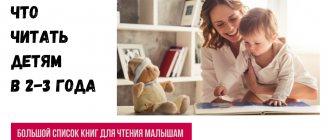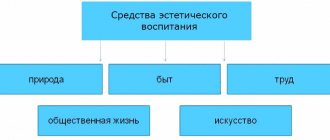Directions of psychological diagnostics
- Screening examination (monitoring) to analyze the dynamics of mental development, identifying people in need of psychological help.
- Identification of the level of readiness or adaptation of children and students to new educational conditions.
- Identification of features and possible causes of maladaptation in order to determine directions for providing psychological assistance.
- Studying the interests, inclinations, abilities of children and students, prerequisites for giftedness.
- Diagnostics of the socio-psychological climate of the team.
- Diagnosis of intellectual, personal and emotional-volitional characteristics.
Based on these areas of psychological diagnostics, the educational psychologist selects methods and techniques that he will use in his work with children. You can find a list of some techniques below.
Methodological recommendations on the topic: “Methods of group work of a teacher-psychologist with a preschool educational institution team”
Methodological recommendations on the topic: “Methods of group work of a teacher-psychologist with a preschool educational institution team”
Teacher-psychologist Safonova T.A.
In order to increase the psychological competence of preschool educational institutions teachers, including orientation in the patterns of child development, in matters of education and conditions in preschool educational institutions for the development of personal formations, an educational psychologist can use a number of methods:
- lecture;
- workshop;
- group consultation;
- training;
- brainstorming method;
- business game;
- round table;
- conversation.
It is also necessary to include types of work that would help improve the emotional well-being of teachers, relieve tension and feelings of discomfort. The most effective are relaxation breaks.
Let's look at some methods.
1. Lecture
. This is a method of transferring ready-made knowledge by a lecturer to an audience. When working with teachers, it is rational to use it in combination with other methods of a more practical orientation, in connection with the characteristics of the audience and the target field of their activity. The structure of the lecture should include the key points of the problem and have a logical clarity of construction:
- introduction (relevance, practical significance of the topic or problem);
- main part (formulation of basic concepts, disclosure of structure and relationships, classification);
- conclusion (highlighting the main idea, summarizing).
There are several types of lectures:
Lecture-conversation.
It takes place in direct contact with the audience. With its help, the presenter has the opportunity to attract the attention of listeners to the key points of the lecture and indirectly use collective experience and knowledge. The negative point is that during a lecture-conversation it is impossible to involve all participants in the discussion.
Lecture-discussion.
It involves the use of a free exchange of opinions between the presenter and listeners between logically structured blocks of the lecture, which allows step-by-step control of the process of mastering the material. To effectively conduct a lecture-discussion, it is necessary to prepare questions. This method allows the presenter to control the opinion of the majority and change the negative attitudes of individual audience members.
Lecture-consultation.
It is most effective when presenting practical material. Involves the lecturer's answers to questions from listeners after presenting the topic. This takes up approximately half of the total lecture time. This method allows the presenter to track the effectiveness of the lecture, discover the problems of listeners, their professional and personal orientation.
These types of lectures can be used in work with both teachers and parents.
There are several other types of lectures (lecture with intensive feedback, lecture with analysis of micro-situations, etc.). At their core, they duplicate in some aspects the above, and therefore do not require detailed consideration.
- Workshop.
A type of lesson whose purpose is to provide the opportunity for the practical use of theoretical knowledge. It involves intensive independent work by the participants and the facilitator on the topic assigned to them. During the workshop, there is a direct exchange of experience, and options for solving certain problems are considered.
- Group consultation. IN
basically has the same structure as an individual consultation. Its psychological meaning is to help a person solve the problem himself, which presupposes the activity of all participants in the consultation and equal positions of the presenter and the audience. The content of the consultation should concern the most important and significant issues identified during observations or surveys. The goal of group counseling should be to help participants solve problems on their own.
4. "Brainstorming"
or brainstorming. This is a method of activating mental activity, designed to produce ideas or solutions to a particular problem. The use of this method must be carried out in accordance with the rules:
a) the group should consist of 7-10 people;
b) criticism of other people's ideas is prohibited; only respect can be shown towards other people's opinions;
c) someone else’s idea can be developed, or you can offer your own;
d) the chairs of the participants should be in a circle;
e) participants must be in a state of emotional and muscular relaxation;
f) All ideas from participants must be recorded. Any ideas can be proposed, even the most
fantastic, and they all have a right to exist. Further, during the accumulation of ideas, the most rational and effective ones in a particular situation are adopted. It is necessary to follow the rule of “4 analogies”:
- direct analogy
(participants are asked to think about how problems similar to this one are solved);
- personal analogy
(participants are asked to enter into the image of the object given in the problem and reason from its point of view);
- symbolic analogy
(participants are asked to imagine solving the problem from the point of view of unreal fairy-tale heroes).
Fantastic analogy (participants are asked to imagine solving the problem from the point of view of unreal fairy-tale heroes).
There are other methods for activating the group’s thought processes:
- focal object method
(the essence is that the characteristics of several randomly selected objects are transferred to the object in focus, resulting in unusual combinations, the development of which leads to the development of original ideas);
- test question method
(involves the use of questions aimed at changing objects, weight, size, material, shape, direction, etc.).
The brainstorming method stimulates the development of group dynamics, which should not be spontaneous; the task of the leader is to indirectly direct this movement, indirectly regulate it. It is important to catch the tension that has arisen in the relations of the participants in time and smooth it out.
5. Training.
An active method of group work, the use of which requires compliance with certain rules. The criteria for selecting training participants are as follows:
- voluntariness of joining the group, desire to participate in the training;
- approximately the same age of the participants (it was noted that after 45 years, participation in the training is not effective);
- the number of group members should not exceed 12 people;
— the training group should involve people who are strangers to each other;
- People with obvious physical defects and mental disorders should not participate in the training.
The facilitator must have a certificate indicating preparation for leading training groups.
In teaching teams, it is more effective to use elements of training, due to the fact that organizing full-fledged training groups is most often impossible. This is a consequence of a number of features: work hours, the overlap of personal relationships with business ones, wide age boundaries, etc.
However, if the situation in the teaching team meets the requirements for their participants in solving a number of problems, training seminars or workshops can be considered a fairly highly effective equivalent of training.
6. Business game.
Refers to gaming technologies in the educational process. This is a type of activity that involves solving any problems in a situation of artificially created conditions. A business game creates an emotionally positive mood for the participants, which allows them to avoid tension while solving a game problem. During business games the following are simulated:
- relationships;
- interactions;
— organizational and structural aspects. Before starting a business game, the participants must develop rules of interaction.
— discussion of what is happening in the group at the level of personal and business relationships should be “here and now”;
- all expressed ideas have the right to exist, since even the most implausible idea can positively influence the development of a group decision;
- statements must be on topic, empty ranting must be excluded;
- your opinion or position must be expressed in a concise form, saving the time of other participants;
- criticism of other people's ideas should be excluded; they can only be developed and supported.
Evidence of the effectiveness of group work during a business game is the appearance of so-called increments among the participants.
Conducting a business game requires a certain deployment logic. Before it starts, the presenter must prepare documentation required by the course of the game. The documentation also includes a dictionary of terms and concepts that ensures their unambiguous interpretation.
Next you need:
- highlight an object or process modeled in the game;
- prepare a game prospectus (disclose its content, conditions of use, in other words, explain what activity is modeled in the game, where the scope of its application is);
- develop a scenario that includes characteristics of the game object and the establishment of roles;
- organize a gaming environment that is closest to real conditions;
- establish regulations;
- appoint an administrator who will lead the group of game organizers;
- form gaming teams;
- distribute roles;
- create a group of experts to analyze conflicts that have arisen;
- select a counting group (if necessary);
- choose a person to create interference and accidents (if this is provided for by the rules of the game).
In the process of working with teachers, a psychologist can also use methods such as psychotechnical games1. They allow teachers to reduce mental stress, develop their internal potential, and effectively manage their internal state, which will ultimately have a positive impact on professional and personal growth. Such games do not require special organization or expense, and after training, teachers can use them in their daily lives.
Relaxation games.
Necessary for removing internal “clamps” and tension. Allows you to gain a sense of stability and relief from stressors. This is a kind of “psychological shower”, necessary for people whose professions involve stressful situations.
Adaptation games.
Designed to optimize the process of professional adaptation of young teachers and, above all, to develop the ability to manage themselves and control their emotional states.
Formula games.
These games are based on the method of verbal self-suggestion. The text of the formulas should be in the form of self-orders that are spoken to oneself. The effectiveness of such games will be quite high if you follow the rules:
- unshakably believe in the power of self-hypnosis formulas;
- when pronouncing the formula, you need to concentrate and concentrate;
- the formula must be repeated 5-7 times;
- the text of the formula should be short and concise;
- the beginning of the formula must include the following statements:
“I can…”, “I know that...”, “I feel that...”, “I am convinced that...”
Formula games can have the following orientation:
- mood for an active position during the day;
- attitude towards confident behavior;
- positive attitude towards work,
children, parents.
Thus, psychological science offers practical psychologists a fairly wide range of methods and forms of active group work with teachers. It is important to choose from them adequate to the goals and needs of a specific group of people - the teaching staff of a preschool institution. The psychologist needs to identify the potential capabilities of teachers, as well as determine the range of problems that exist for them, and based on their analysis, build further work.
Diagnostics of adaptation to preschool education
Monitoring a child during the adaptation period is an important diagnostic direction in the work of a psychologist. It allows you to collect data about the child and draw a conclusion about the degree of adaptation to kindergarten. There are many techniques with which you can carry out this observation. I suggest you get acquainted with the list of some of them.
- Ronzhina A.S. “Diagnostics of the level of adaptation of a child to a preschool institution.”
- Methodology of A. Ostroukhova “Studying the degree of adaptation of a child at a preschool educational institution.”
- Methodology of Vatutina N. D. “Determination of the degree of adaptation to preschool educational institutions.”
Diagnosis of readiness for school
- Yasyukova L.A. Methodology for determining readiness for school.
- Semago N.N., Semago M.Ya. “Psychological and pedagogical assessment of readiness to start school.”
- Ekzhanova E.A. "Diagnostic and prognostic screening in the first grades of secondary schools."
- Varkhatova E.A., Dyatko N.V., Sazonova E.V. "Express diagnostics of readiness for school."
- Method of express diagnostics of intellectual abilities of children 6-7 years of age (MEDIS)
- Kern-Jirasek School Maturation Test.
Developmental and preventive program for the work of a teacher-psychologist with children in kindergarten
Personal readiness.
Includes the formation of a child’s readiness to accept a new social position - the position of a schoolchild who has a range of rights and responsibilities. This readiness is expressed in the child’s attitude towards school, educational activities, teachers, and himself. Personal readiness also includes a certain level of development of the motivational sphere. A child who is ready for school is one who is attracted to school not by its external aspects (the attributes of school life - a briefcase, textbooks, notebooks), but by the opportunity to acquire new knowledge, which involves the development of cognitive interests. The future schoolchild needs to voluntarily control his behavior and cognitive activity, which becomes possible with the formation of a hierarchical system of motives. Thus, the child must have developed learning motivation. Personal readiness also presupposes a certain level of development of the child’s emotional sphere. By the beginning of school, the child should have achieved relatively good emotional stability, against the background of which the development and course of educational activities is possible.
Intellectual readiness.
This component of readiness presupposes that the child has an outlook and a stock of specific knowledge. The child must have a holistic perception, elements of a theoretical attitude to the material being studied, generalized forms of thinking and basic logical operations, and semantic memorization. However, basically, the child’s thinking remains figurative, based on real actions with objects and their substitutes. Intellectual readiness also presupposes the development in a child of initial skills in the field of educational activity, in particular, the ability to identify an educational task and turn it into an independent goal of activity. To summarize, we can say that the development of intellectual readiness for learning at school involves:
differentiated perception;
analytical thinking (the ability to comprehend the main features and connections between phenomena, the ability to reproduce a pattern);
rational approach to reality (weakening the role of fantasy);
logical memorization;
interest in knowledge and the process of obtaining it through additional efforts;
mastery of spoken language by ear and the ability to understand and use symbols;
development of fine hand movements and hand-eye coordination.
Social and psychological readiness.
This component of readiness involves developing in children the qualities that enable them to interact with other children and teachers. A child comes to school, a class where children are engaged in a common task, and he needs to have fairly flexible ways of establishing relationships with other people, the ability to enter the children's society, act together with others, the ability to give in and defend himself. Thus, this component presupposes the development in children of the need to communicate with others, the ability to obey the interests and customs of the children's group.
Diagnostics of cognitive processes
Now there are many different diagnostic kits, which have already selected all the necessary methods for diagnosing cognitive processes in children of different ages. All you have to do is choose which one you like best. Below I have provided a list of the most popular ones.
- Rudenko L.G., Pavlova N.N. Express diagnostics in kindergarten: a set of materials for educational psychologists in preschool educational institutions.
- Rudenko L.G., Pavlova N.N. Psychological diagnostics and correction at an early age.
- Strebeleva E.A. Psychological and pedagogical diagnostics of the development of children of early and preschool age.
- Kurazheva N.Yu., Kozlova I.A., Tuzaeva A.S. Diagnostic complex “Tsvetik-Semitsvetik” for children 3-7 years old.
- Zabramnaya S.D., Borovik O.V. Practical material for psychological and pedagogical examination of children
Main activities of a teacher-psychologist
Under psychological education
refers to the familiarization of adults (educators, parents) and children with psychological knowledge. Psychological knowledge is not sufficiently widespread in society; a psychological culture that presupposes interest in another person, respect for the characteristics of his personality, the ability and desire to understand his own relationships, experiences, and actions is not always expressed. In teaching teams, as well as in families, conflicts are possible, based on the psychological deafness of adults, the inability and unwillingness to listen to each other, understand, forgive, give in, etc. Therefore, it is important for a practical psychologist to increase the level of psychological culture of those people who work with children. The main meaning of psychological education is to familiarize educators and parents with the basic patterns and conditions for the favorable mental development of a child, to popularize and explain the results of psychological research, to create a need for psychological knowledge and a desire to use it in working with a child or in the interests of developing one’s own personality, and also to achieve an understanding of the need for practical psychology and the work of a psychologist in kindergarten and other educational institutions. Psychological education can take place in the form of lectures, conversations, and seminars.
Psychological prevention
- a currently poorly developed type of activity of a practical child psychologist. It is aimed at preserving, strengthening and developing the psychological health of children at all stages of preschool childhood. Unfortunately, this side of the activity of a practical psychologist is not yet developed in our country. But this does not diminish its role. Psychological prevention presupposes responsibility for observing in kindergarten (and other children's institutions) the psychological conditions necessary for the full psychological development and formation of the child's personality at each age stage. Also, psychological prevention involves the timely identification of such characteristics of a child that can lead to certain difficulties, deviations in intellectual and emotional development, in his behavior and relationships. The main difficulty that a psychologist may encounter is the lack of understanding by the teaching staff and parents of the importance of psychological prevention. Such a misunderstanding can be explained by the fact that there are many problems with individual children and groups that urgently need to be addressed and therefore educators and parents may not think about what might happen in the future. A psychologist should try to predict the possibility of problems arising and work towards their prevention. In psychoprophylaxis, the initiative comes entirely from the psychologist, this shows his creativity as a specialist. A psychologist develops and implements developmental programs for children of different ages, taking into account the characteristics of each age stage. It also identifies such psychological characteristics of the child that may subsequently lead to the emergence of certain difficulties or deviations in his intellectual and personal development. A practical psychologist must monitor the observance in kindergarten of the conditions necessary for the normal mental development and formation of the personality of children at each age stage, as well as prevent possible complications in the mental development and formation of the personality of children in connection with their transition to the next age level.
Psychological diagnostics –
psychological and pedagogical study of individual personality characteristics... with the aim of:
- identifying the causes of problems in learning and development;
- determining the strengths of the individual, his reserve capabilities, which can be relied upon during correctional work;
- early identification of professional and educational interests;
- determining the individual style of cognitive activity, etc.
It is carried out in the form of planned diagnostics or diagnostics upon request... of the administration, teachers, parents and is considered as an important preparatory stage of individual and group counseling, psychological and pedagogical consultation, teachers' council...
Psychological diagnostics of professional behavior... is carried out by a psychologist either within the framework of the strategy of his own professional activity developed by him, or upon request... and is carried out in the form of multi-position analysis... based on observations, video filming or other recording...
Advisory work
in kindergarten has a fundamental difference from that carried out by a psychologist in district or other consultations. The specificity of such counseling is that it focuses on solving professional problems. During the consultation process, only what is relevant to solving the main task of the educational psychological service is considered - to maximally promote the mental, personal development of each child. Kindergarten managers, teachers, parents and other people receive advice insofar as they are related to the child. Their problems are considered only in connection with the problems of children, and not in themselves. Educators often turn to a psychologist on the following issues: reasons for children’s difficulties in mastering educational programs (preparing for school), children’s reluctance and inability to study, emotional and personality disorders, conflictual relationships with other children. Parents often come to us with problems: how to prepare children for school, lack of expressed interests in children, poor memory, disorganization, lack of independence, aggressiveness, increased excitability or timidity, timidity; in other words, we mean everything that is usually denoted by the words “difficult child.”
Diagnostics of personal and emotional-volitional characteristics
- Methodology “Emotional faces” (N.Ya. Semago) (Goal: assessing the possibility of adequate recognition of the emotional state, the accuracy and quality of this recognition.)
- Anxiety test (Temml R., Dorki M., Amen V.) (Purpose: determining the level of anxiety).
- Test for identifying children's fears A.I. Zakharov and M. Panfilova “Fears in houses” (Goal: identifying and clarifying the prevailing types of fears in children over 3 years old).
- Eight-color Luscher test (Purpose: study of the child’s emotional state).
- “Ladder” technique. Modified by S.G. Yakobson, V.G. Shchur. (Purpose: self-esteem research).
- “Locomotive” technique (S.V. Velieva) (Goal: determining the characteristics of the child’s emotional state).
- Methods for studying children's self-awareness (N.L. Belopolskaya) (Purpose: to study the level of formation of those aspects of self-awareness that are associated with the identification of gender and age).
- Graphic technique M.A. Panfilova “Cactus” (Goal: identifying the state of the child’s emotional sphere, identifying the presence of aggression, its direction and intensity).
- Methodology “Magic Land of Feelings” (Purpose: study of the psycho-emotional state of the child).
- Makhortova G.Kh. Projective methodology for personality research “Tell a story.” (Purpose: personality research).
Diagnosis of parent-child relationships
In the standard “Teacher-psychologist (psychologist in the field of education)” such an area as diagnosing child-parent relationships is not highlighted, but I felt that it needed to be voiced. After all, we must work with the child in conjunction with all participants in educational relations. Therefore, it is very important for us to understand what kind of relationships a child has in his family and how this can affect his behavior and development.
- Projective technique “Family Drawing”. This technique is aimed at diagnosing emotional well-being and the structure of family relationships.
- Test “Diagnostics of emotional relationships in the family” Authors E. Bene and D. Anthony (under the general editorship of A.G. Leaders and I.V. Anisimova). This test is aimed at studying the emotional relationships of a child in the family.
- Rene Gel's projective technique. Research into the sphere of a child’s interpersonal relationships and his perception of intrafamily relationships
- Children's Apperception Test (CAT) (Authors: Leopold and Sonya Bellak)






